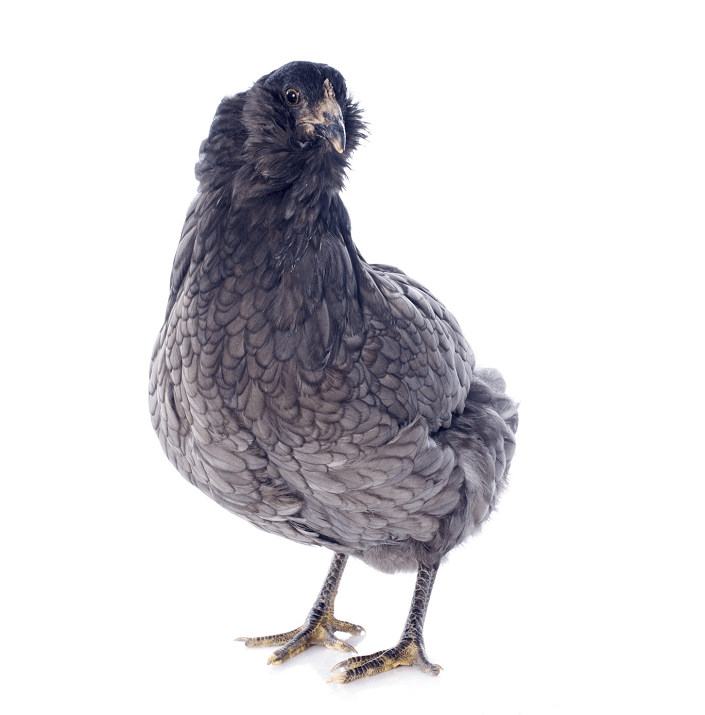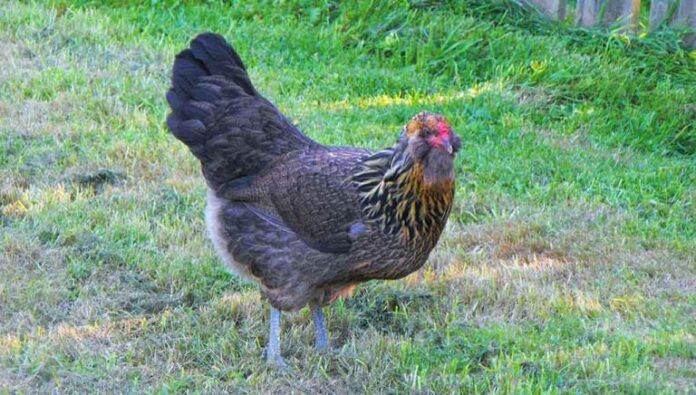Last Updated on July 2, 2021 by Fumipets
The Ameraucana chicken is one of a kind among its contemporaries.
It is a relatively new addition to the chicken breeds, first appearing in the 1970s.
It has a committed fanbase of breeders and followers in many countries, and it is progressively attracting more devotees.
As we will see, the Ameraucana’s history is a little complicated.
This post will go into the temperament, egg-laying, colour variants, and more of the Ameraucana.

Overview
| Ameraucana Chicken | |
|---|---|
| Beginner Friendly: | Yes. |
| Lifespan: | 7-8 years. |
| Weight: | 5-7lb. |
| Color: | Varied. |
| Egg Production: | 3-4 per week. |
| Egg Color: | Light blue. |
| Known For Broodiness: | No. |
| Good With Children: | Yes. |
| Cost of Chicken: | $18+ chick. |
Origins and History
This breed’s recent history may be traced back to the 1920s in South America, namely Chile.
Originally, the Mapuche Indians had two varieties of chickens: Collonca and Quintero.
Even the Indians knew about these breeds, which were first documented and written down by the Spanish conquerors in the 1500s.
The Araucana was created when the two kinds were mixed together, either spontaneously or via human intervention — no one knows.
The Araucana chicken’s parent bird is the Araucana.
The Araucana chicken was (and continues to be) a rare species. It has a fatal gene that may kill chicks in the shell due to its genetic composition.
The Araucana’s tufted ears are due to a fatal gene. The chicks will die in the shell if both parents have the tufting gene (ET).
Ameraucanas were developed to maintain the blue egg gene while removing their parents’ fatal gene.
The Araucana was imported to the United States in small numbers in the 1920s when Professor Salvador Castillo presented the bird at a conference in Santiago, Chile.
Mr. Keller of the Pratt Experimental Farm in Pennsylvania was one among the people responsible for rearing Araucanas and finally ‘creating’ the Ameraucana.
He mixed Araucanas with other birds, resulting in a kaleidoscope of species.
Araucanas were characterised by ear tufts, muffs and beards, rumplessness, full tails, and other characteristics.
Araucanas and Ameraucanas, whether rumpless or tailed, are recognised as the same breed in the United Kingdom, Australia, and many other nations.
Appearance and Temperament
The Ameraucana’s coloration is widely diverse, with a variety of colour palettes to pick from, ranging from black to white, blue to wheaten. This is a lovely bird due of the diversity of colours available.
It is a dual-purpose breed that is cold hardy.
The beard and muffs give the bird a chipmunk-like appearance, with their cheeks puffed out!
They have a menacing appearance due to their bay red eyes, however they are a really placid bird. The appearance is however quite misleading.
A broad range of behaviours in the evaluations for this bird’s disposition has been reported.
It’s difficult to say if this is due to upbringing or other situations. Its personality has been described as shy of calm and gentle.
It’s a nice bird in general, although it doesn’t always love being taken up and caressed.
The Ameraucana is normally social among its own species and occupies a moderate position in the pecking order.
It also appreciates human engagement and touch; most people describe it as a bright and predator-savvy bird.
The Ameraucana is reported to have a hawk-like aspect, which some people love in free-range flocks.
Mimicry is supposed to dissuade attacks by real hawks and other animals. Their bay red eyes’ laser-focus further contributes to this idea.

Breed Standard
In 1984, the American Poultry Association recognised the Ameraucana. There’s also a bantam Ameraucana that was recognised by the American Bantam Association in 1979.
The wattles and pea comb of the Ameraucana are both crimson. Wattles are usually tiny or perhaps non-existent.
The colour of the eyes is a reddish bay.
Both beards and muffs are seen on Ameraucanas. It might be difficult to tell the difference between the muffs and the beard, but a detailed look should help.
The tail should be held approximately at a 45-degree angle to the body.
Legs and feet should be slate blue to black, depending on the colour of the plumage.
Each foot should have four toes and the shanks should be free of feathering. The skin on the bottom of the foot, like the skin on the bird, is white.
The Ameraucana comes in eight distinct colours; black, blue, wheaten, eddish brown, b uff, white, wheaten and silver
The Ameraucana is a light bird, with males weighing approximately 6.5 pounds and females at approximately 5.5 pounds.
Bantams should weigh between 26 and 30 ounces f or males and 24-26 ounces for f emales.
Broodiness and Egg Laying
The Ameraucana is adored for its’ light blue eggs. It’s an excellent layer, laying approximately 3–4 medium-sized eggs every week. It’s a slow starter, so don’t anticipate your eggs until 18-20 weeks.
Some folks reported they had waited 5-7 months before any eggs appeared.
Blue eggs were formerly touted as having lower cholesterol and higher protein content. This was only a marketing gimmick to pique people’s curiosity in blue eggs.
Blue eggs were not always popular, which may seem surprising today.
The eggs are nutritionally equivalent to green, brown, pink, or white eggs.
The majority of Ameraucanas are not broody. Broodiness happens from time to time, although it is not common.

Health Issues
Unlike its parents, the Araucana, the Ameraucana has no serious health problems.
On average, they will survive for 7-8 years. They also outlive other breeds in their flock because to their predator-savvy skills.
Another feather in their crown is that they are superb foragers and are astute when it comes to their adversaries.
Coop Setup
The magic rule of 4 square feet per chicken applies while constructing the coop.
You can get away with somewhat less if they are permitted to free roam every day, but more room is always preferable than less.
You won’t go f wrong if you offer each bird 8 inches of roosting area. In the summer, the chickens like to stretch out, whereas in the winter, they prefer to huddle close.
The normal size for nesting boxes is 12 by 12 inches, which will enough. If you construct anything bigger, a few of chickens may nest together, resulting in broken eggs, so try to keep them apart.
Is Ameraucana the Right choice for You?
These birds are known for being gentle and sociable. They are fairly resilient, yet some people claim they can’t stand cold temperatures.
They seem to be able to cope with New York winters as long as their quarters are dry and draft-free.
The Ameraucana can tolerate captivity, but not so well. They are highly independent birds, so if they have the opportunity, they like to free-range.
For many people, the fact that they lay a moderate to large number of pale blue eggs is a great benefit.
Blue eggs seems to be becoming a ‘thing’ in several stores, where they sell for a reasonable price!
Most roosters may be a little grumpy at times, but they aren’t very hostile, according to my study.
Others have claimed that their Ameraucanas have difficulty surviving in humid and hot situations.
The colourful heritage of the bird in issue may have a lot to do with the disparities in experiences.
Cautionary Note
Many hatcheries and other breeders sell Americana or Americauna birds. These aren’t Ameraucanas – note the spelling…
For many years, it has been utilised as a marketing tactic. They are, in fact, most folks are selling Easter Eggers, which is not a pure breed.
While there’s nothing wrong with Easter Eggers, you should know the difference since many private “breeders” don’t.
A telltale clue in some hatchery catalogues is whether the birds are labelled as “recommended for laying or not for display or 4H usage.”
Because Ameraucanas are still a scarce species, if you spend $5-10 for one, it’s probably not a pure breed.
A pure Ameraucana hen costs approximately $20.00 and a rooster costs approximately $18.00.
The Easter Egger is a cross between an Ameraucana or an Araucana and another chicken breed.
The Ameraucana and Araucana, on the other hand, are considered pure breeds.
The Easter Egger, like the Araucana and Ameraucana, may lay blue eggs, wear muffs, and even develop beards.

Conclusion
In the United States, the Ameraucana is still considered an uncommon breed. If you can afford it, getting a few of these magnificent birds is definitely worth the investment.
As previously stated, the Araucana and Ameraucana are regarded the same breed in Australia, the United Kingdom, and many other nations, which might be confusing!
The Ameraucana is a lovely addition to your flock, both in terms of plumage and colourful egg production.


















